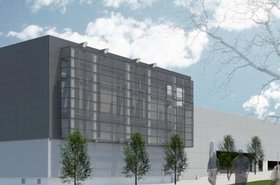Currently home to more than 1.4 billion people, with this figure projected to double by 2050, it’s safe to say that Africa’s digital expansion is only just beginning.
Estimates show that by 2025, 615 million users in Sub-Saharan Africa will subscribe to mobile services – a 24 percent increase from 2020 – illuminating the fact digital demand is not only increasing at scale, but at breakneck speed.
Fortunately, due to a young population, Africa is fairly well served in terms of internet penetration, but lacks the advanced digital infrastructure required to support growth of this magnitude.
But for both local and international investors, there is little difference between obstacle and opportunity, with many now recognizing the region’s burgeoning need for high performing, reliable data center space.
“In Africa there’s this massive rush for organizations to digitize,” says Michael Abendanon, head of MEA at NTT Global Data Centers.
“Data centers have become the epicenter of this digital explosion, so we’re seeing a lot of international companies making acquisitions and expanding their data center footprint in Africa, and local organizations are doing the same. There’s a lot of growth at the moment and there’s still a lot of growth to come.”
NTT is proud to be part of this growth, and alongside Dimension Data – the South African systems integrator, managed services provider and wholly owned subsidiary of NTT – has recently opened its Johannesburg 1 Data Center in South Africa, as part of the company’s expansion across the African continent.
With 11 data centers already operational across Africa, Dimension Data’s regional experience, in tandem with NTT’s leading global technology services, are the perfect match to deliver the world-class facilities needed to support, and accelerate, the region’s digital transformation journey.
“A unique differentiator we have is that we’ve operated in these markets for many years,” says Abendanon. “Dimension Data has been in the Middle East and Africa for 40 years, and we have significant business in South Africa, so our ability to execute in these markets with a large pre-existing system integration footprint is very good.”
Location, location, location
With an already well-established foothold in markets across Angola, Botswana, Mozambique, Kenya, and Uganda, naturally we wanted to know, why Johannesburg?
“Dimension Data’s South African head office is located in Johannesburg, and we already have a significant presence and customer base there, so it was a natural entry point for NTT’s Global Data Centers.”
Johannesburg has always been a preferred entry point into Africa for many international organizations, largely thanks to the maturity of its financial markets, as well as the swathes of large corporations and ancillary service organizations already established within the city.
“Hyperscalers in particular are looking to locations like Johannesburg because they wish for colocation services, hosting services, and those stable, mature markets, large populations and internet penetration,” says Abendanon.
“We very much go where the hyperscalers want to go. They’re interested in Johannesburg, they’re interested in Cape Town, and other African cities for similar reasons.”
Indeed, Johannesburg 1, caters to both hyperscalers and enterprises alike, providing them with the opportunity to use NTT’s full stack of ICT services, including managed hybrid cloud, network management, collaboration, security, and application monitoring.
Once fully built out, the facility will boast 12MW of capacity, 6,000m2 of IT space, and equip clients with the dedicated digital infrastructure, operational control, and design flexibility required to provide the latest in digital services.
Global experience on a local level
In the EMEA region alone, NTT currently successfully operates 44 data center buildings. To make that possible, the company has close to 1,000 staff with the capabilities required to keep these facilities operational.
“From mechanical and electrical engineers, to vast legal, financial, expansion and design procurement teams, we’re equipped with all the facets needed to run a successful data center business,” says Abendanon.
“We are able to replicate our global experience into emerging markets, and in this case, we’re leveraging that expertise into Africa. Of course, each location requires some local nuance and we have that in abundance.”
And the importance of that local nuance cannot be understated. Not all data centers are (or can be) created equal, and it pays dividends to work with a company that recognizes different locations come with different considerations. What might work well in one geography, won’t necessarily work well in another.
When designing and constructing a data center in South Africa, this location had its own set of unique challenges.
As a region threatened by drought and therefore potential restrictions on water, Johannesburg 1 was designed to use a closed-loop chilled water system with air-cooled chillers. This not only makes for a highly redundant cooling system but, because the water running through it isn’t evaporated, means that both a low WUE (water usage effectiveness) and PUE (power usage effectiveness) can be achieved.
In terms of reliability, in all mission critical facilities, downtime simply isn’t an option, and data centers have to have a certain amount of redundancy built in, to ensure the facility can continue to run should the primary equipment or infrastructure fail. This is particularly crucial in South Africa, where the risk of a power outage is by no means uncommon.
“Power is definitely one of the more holistic challenges to South Africa,” says Abendanon. “Back in the 2000s Eskom – South Africa’s national energy provider – was one of the best power producers in the world. However, over the last 20 years, there has been a lack of investment or maintenance in those major power stations across the region. Consequently, demand has exceeded supply and, as a result, the country is facing crippling power outages.”
Despite this, the rewards of locating in South Africa still massively outweigh the risks, therefore businesses – and hyperscalers – are undeterred from wanting to set up shop in the area. But it does mean they need to partner with a company that can understand and mitigate the risks.
“Johannesburg 1’s technical infrastructure is supported by what we call N+1, which is a combination of an uninterruptible power supply system (UPS), generation, and backup,” says Abendanon.
“You have to be really careful in terms of the way you design your data centers. These systems cannot go down, never ever. So, in South Africa, we’re very focused on making sure that power is always available.”
NTT also ensures a steady supply of diesel, through the utilization of different ports, storage facilities and suppliers. The company also has two completely separate routes to Johannesburg, so in all possible scenarios, should one supply of diesel go down, the facility is never without backup.
Sustainable solutions
“There’s a lot of focus from us in Africa to ensure we consume sustainable power, so we are able to meet the overall ambitions of the NTT group. We have made a commitment to net-zero emissions across our operations by 2030 and across our value chain by 2040.”
And despite its potential for outages, Africa is incredibly well positioned in terms of green energy, with the south benefiting from an abundance of wind and solar power. But of course, the sun doesn’t always shine, and the wind doesn’t always blow, another obstacle that, for those with the capabilities, signals an opportunity to innovate.
“We are making great progress in terms of ‘how do we overproduce when the sun is shining, and store in the form of battery storage to filter into facilities when it isn’t’. We’re seeing a rapid acceleration in that technology, particularly in the world of data centers, and the industry is certainly going to see that ramp up going forward,” says Abendanon.
Moving over to the east, Kenya – a pioneer in mobile payments with the M-Pesa system – enjoys a steady supply of geothermal power courtesy of the Great Rift Valley.
“Ninety-three percent of the power grid in Kenya is actually green, because turbines powered by steam from the Great Rift Valley power the nation. So, if you build a data center in those markets, you’re 93 percent green from day one.”
Investing in tomorrow
Bolstering an already significant global data center footprint, Johannesburg 1 may be NTT’s first South African flag in the ground, but it comes at a time when the demand for digital content, cloud services, new technology and content delivery networks are at an all-time high, and will only continue to rise.
“It's massive direct foreign investment into this country and means the hyperscalers can come in and offer first world platforms not only to corporations, but local citizens. It means providing a borderless offering of services, it means borderless societies, which is very exciting for Africa,” says Abendanon.
Utilizing a proven combination of global connectivity, carrier neutrality, cloud network access, and on-site support, the opening of Johannesburg 1 will not only help contribute towards the economic growth and social development of South Africa as a region, but provide both NTT’s clients, and local communities, the tools they need to help shape the country of tomorrow.
Find out more about NTT's Johannesburg 1 data center, here.
More from NTT
-

DCD>Talks Madrid with David Van Elswyk, NTT
David Van Elswyk, Site Operations Manager at NTT, sits down with Vlad-Gabriel Anghel to talk about the growing Madrid data center region.
-

Connect planet, community, and economy
NTT unpacks the importance of connectivity in sustainability
-

NTT building private wireless network for Las Vegas
Vegas gambles on private 5G network

